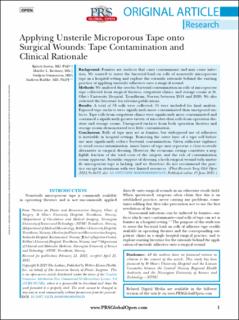| dc.contributor.author | Ausen, Kjersti | |
| dc.contributor.author | Kroknes, Marthe Lind | |
| dc.contributor.author | Gunnarson, Gudjon | |
| dc.contributor.author | Radtke, Andreas | |
| dc.date.accessioned | 2021-10-28T09:02:15Z | |
| dc.date.available | 2021-10-28T09:02:15Z | |
| dc.date.created | 2021-08-04T15:00:56Z | |
| dc.date.issued | 2021 | |
| dc.identifier.citation | Plastic and reconstructive surgery. Global open. 2021, 9 (6), 1-7. | en_US |
| dc.identifier.issn | 2169-7574 | |
| dc.identifier.uri | https://hdl.handle.net/11250/2826215 | |
| dc.description.abstract | Background: Fomites are surfaces that carry contaminants and may cause infection. We wanted to assess the bacterial load on rolls of nonsterile microporous tape in a hospital setting and explore the scientific rationale behind the existing practice of applying unsterile adhesives onto a surgical wound. Methods: We analyzed the aerobic bacterial contamination in rolls of microporous tape collected from surgical theaters, outpatient clinics, and storage rooms at St. Olav’s University Hospital, Trondheim, Norway between 2018 and 2020. We also reviewed the literature for relevant publications. Results: A total of 58 rolls were collected; 55 were included for final analysis. Exposed tape surfaces were significantly more contaminated than unexposed surfaces. Tape rolls from outpatient clinics were significantly more contaminated and contained a significantly greater variety of microbes than rolls from operation theaters and storage rooms. Unexposed surfaces from both operation theaters and storage rooms demonstrated very little contamination. Conclusions: Rolls of tape may act as fomites, but widespread use of adhesives is inevitable in hospital settings. Removing the outer layer of a tape roll before use may significantly reduce bacterial contamination. Given sufficient vigilance to avoid cross-contamination, inner layers of tape may represent a close-to-sterile alternative as surgical dressing. However, the economic savings constitute a negligible fraction of the total costs of the surgery, and the risk of contamination seems apparent. Scientific support of dressing a fresh surgical wound with unsterile microporous tape is lacking, and we therefore do not recommend the practice except in situations with very limited resources. | en_US |
| dc.language.iso | eng | en_US |
| dc.publisher | Lippincott, Williams & Wilkins | en_US |
| dc.rights | Attribution-NonCommercial-NoDerivatives 4.0 Internasjonal | * |
| dc.rights.uri | http://creativecommons.org/licenses/by-nc-nd/4.0/deed.no | * |
| dc.title | Applying Unsterile Microporous Tape onto Surgical Wounds: Tape Contamination and Clinical Rationale | en_US |
| dc.type | Peer reviewed | en_US |
| dc.type | Journal article | en_US |
| dc.description.version | publishedVersion | en_US |
| dc.source.pagenumber | 1-7 | en_US |
| dc.source.volume | 9 | en_US |
| dc.source.journal | Plastic and reconstructive surgery. Global open | en_US |
| dc.source.issue | 6 | en_US |
| dc.identifier.doi | 10.1097/GOX.0000000000003635 | |
| dc.identifier.cristin | 1923913 | |
| cristin.ispublished | true | |
| cristin.fulltext | original | |
| cristin.qualitycode | 1 | |

